Commercial Floor Cleaning: Best Practices for Different Floor Types
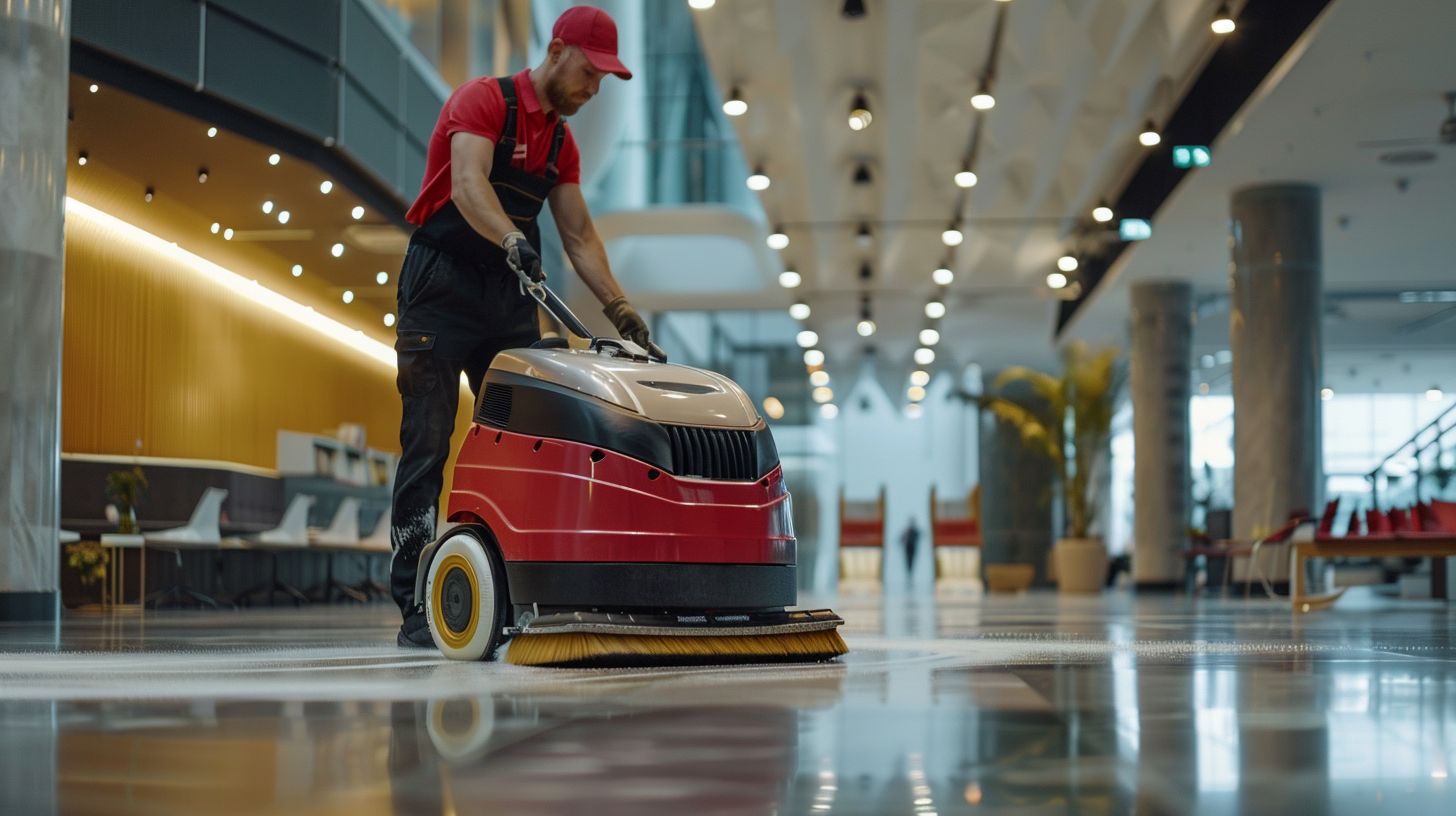
Keeping the floors in a commercial space spick and span is no small feat for professional cleaners – believe us, we know. Different types of surfaces demand their unique approach; for instance, giving carpets a good vacuuming every day.
Our article will discuss how to best care for various flooring options. Expect handy tips on unique treatments and routine upkeep.
See the latest Whitehall Carpet Cleaners Promotions Here! We are experts at deep cleaning commercial carpets across Columbia, SC. Contact our professional cleaners today.
Key Takeaways
- Each type of commercial flooring needs its unique cleaning method and tools. For example, carpets need daily vacuuming and periodic steam cleaning, while tile floors do well with regular mopping and using an automated floor scrubber for deep cleaning.
- Daily upkeep is vital to keep all types of floors looking their best. This includes sweeping or vacuuming to remove loose dirt, using the right mop and cleaner for wet mopping, and applying a finish to protect the floor.
- Restorative maintenance helps fix wear-and-tear issues like scuff marks, scratches, and embedded dirt. Techniques vary depending on the flooring type but can include stripping and refinishing, buffing and polishing, or deep cleaning methods like steam cleaning.
- Eco-friendly practices are essential in commercial floor care. Using green products keeps people safe from harsh chemicals and lessens environmental impact. Good choices include neutral pH cleaners for concrete floors or ammonia-based ones for rubber flooring.
- Putting together a maintenance program requires knowing about different floor types’ unique needs, choosing appropriate supplies and equipment carefully tailored to each one’s requirements, setting up a detailed cleaning schedule that works around your space’s traffic patterns, and considering industry-specific standards where necessary.
Types of Commercial Flooring
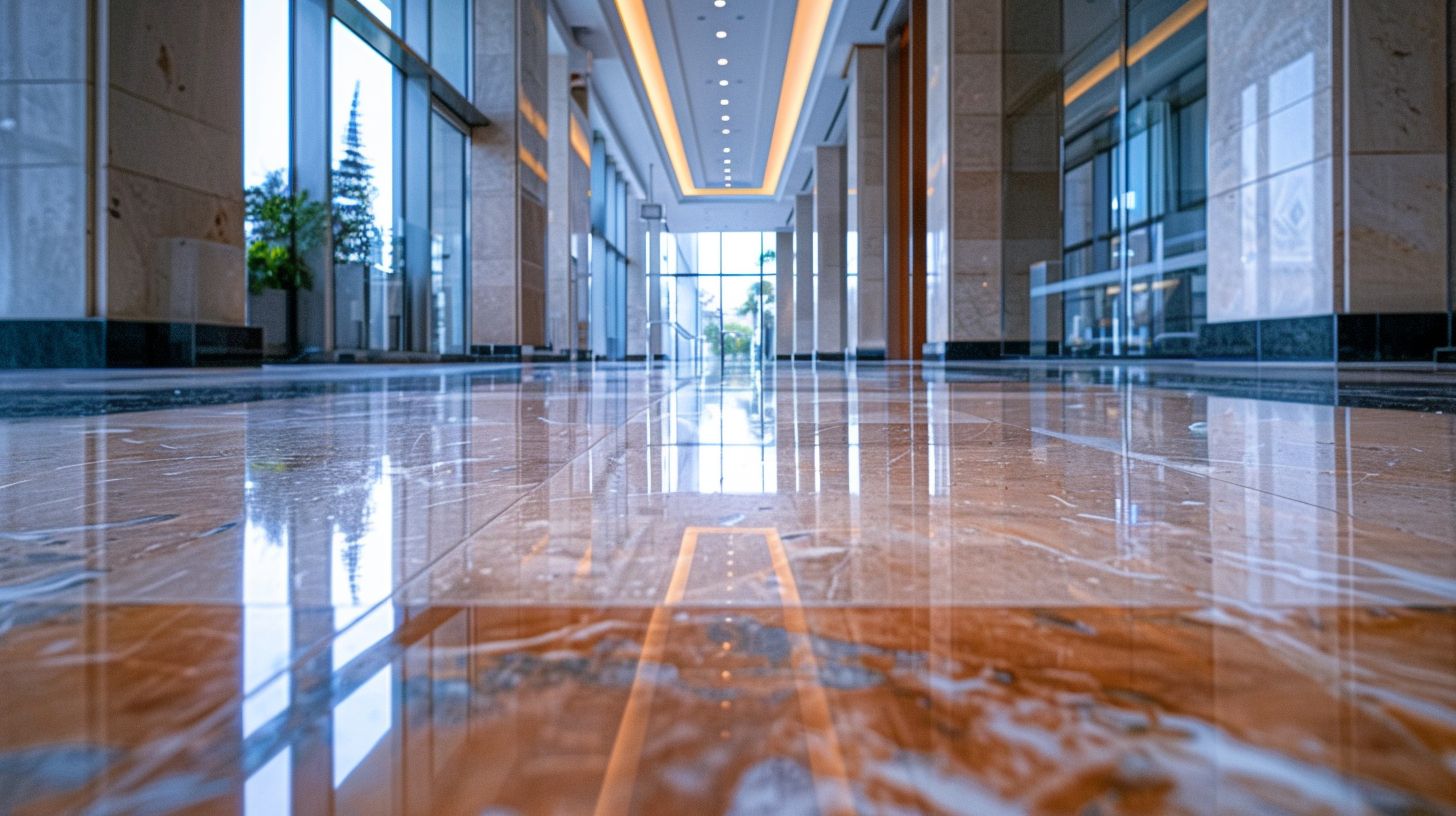
– There are various types of commercial flooring, including carpet, tile floors, concrete, vinyl, laminate, rubber, and stone.
– Each type of commercial flooring requires specific cleaning methods and tools to maintain its appearance and longevity.
Carpet
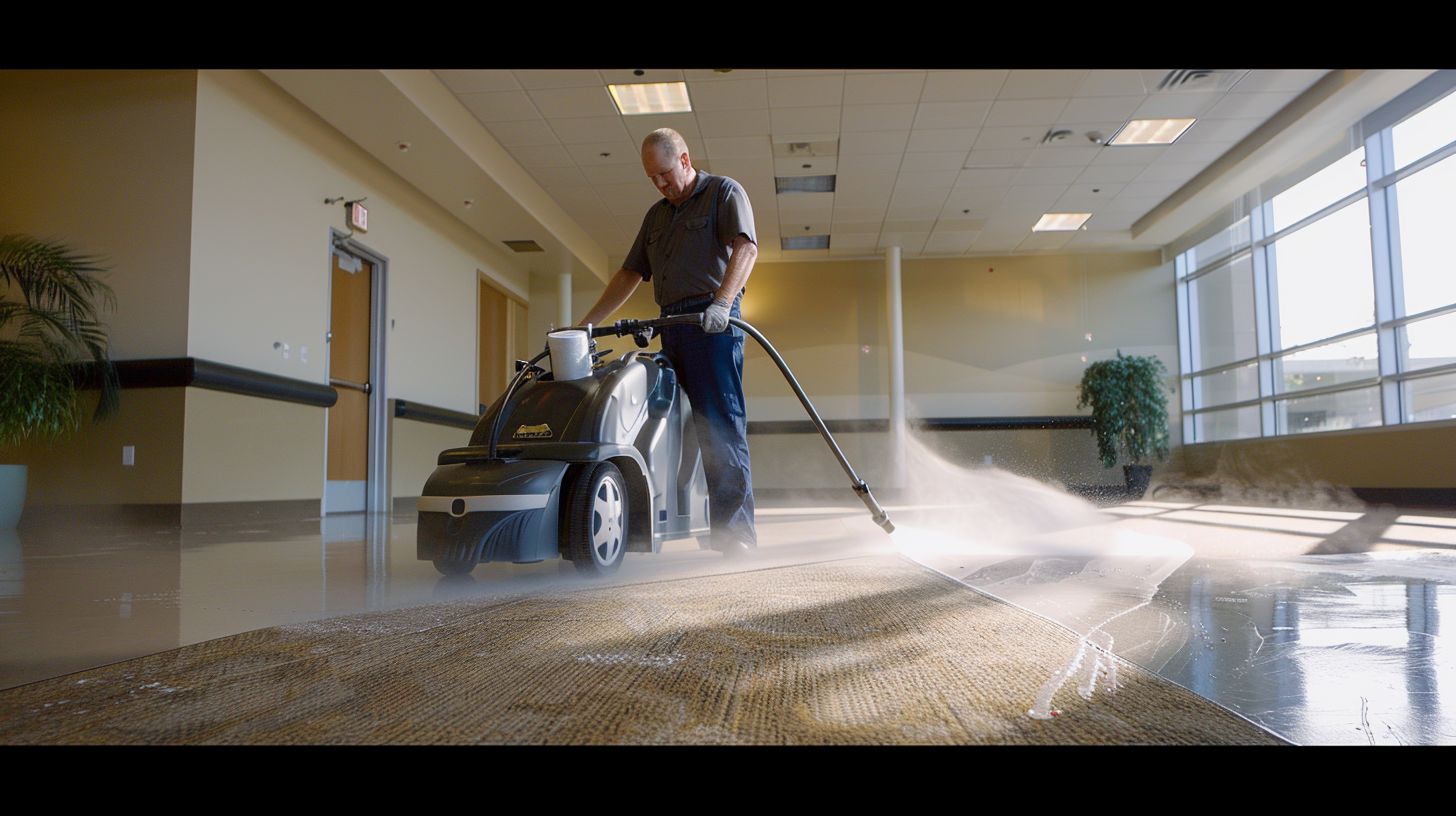
Carpet cleaning in commercial spaces requires a deep understanding of the material’s unique needs. We use steam cleaning or hot water extraction methods to remove stubborn dirt and maintain indoor air quality.
Daily vacuuming with high-quality equipment helps eliminate loose dirt, while periodic deep cleaning keeps carpets fresh and prolongs their life in high-traffic areas.
We employ specialized treatments for tough stains on carpet fibers that avoid harsh chemicals, preserving the carpet’s appearance and durability. Our approach combines routine maintenance with eco-friendly practices to ensure carpets remain clean without damaging the environment or the carpet material.
This strategy supports both cleanliness and sustainability in commercial settings.
Tile Floors
Tile floors are a smart choice for many commercial spaces due to their durability and ease of maintenance. We clean these surfaces with regular mopping and use an automated floor scrubber for deeper cleaning tasks.
The right cleaning solution is crucial to tackle stains without damaging the tile or grout lines. Applying three to five coats of acrylic finish gives tile floors a protective barrier, enhancing their appearance and longevity.
We sweep or vacuum for daily upkeep and clean floors to remove loose dirt before it can scratch the flooring material. Wet mopping with a neutral cleaner keeps the tile looking fresh without leaving residue.
High-traffic areas need special attention; we often repeat these steps throughout the day in such zones. Our team ensures that every inch of your tile surface stays clean, focusing on grout lines where dirt accumulates most.
Concrete
We maintain commercial concrete floors through routine cleaning with auto scrubbers. Their porous nature demands regular attention to prevent dirt absorption and ensure a clean environment.
We start with dust mopping to remove surface debris, then wet mopping using a neutral floor cleaner. After rinsing, we allow the floors to air dry completely.
We apply three to five coats of acrylic floor finish for optimal cleaning outcomes on concrete surfaces. This method not only cleans but also preserves the durability and appearance of concrete floors in high-foot-traffic areas of commercial buildings.
Proper maintenance is crucial for these flooring materials, ensuring they remain in top condition over time.
Vinyl
When it comes to vinyl floors, regular sweeping or vacuuming is essential. Using a damp mop with neutral cleaning detergent helps keep them clean. Applying three to five coats of acrylic floor finish can result in an excellent outcome for vinyl floors, prolonging their life in commercial settings.
To maintain the shine of vinyl floors, it is advisable to use vinegar-based cleaners, baking soda, and lemon-based solutions.
Proper maintenance and regular cleaning practices are crucial for maintaining the quality of vinyl floors. These practices can help prevent wear and tear, preserve the aesthetic appeal of these commercial flooring options, and ensure a hygienic environment.
Laminate
Laminate flooring is low-maintenance and ideal for high-traffic areas. However, daily upkeep must be performed, such as sweeping or vacuuming and periodic mopping using a damp cloth and mild detergent solution.
Using specialized laminate floor cleaners is crucial for vital maintenance to tackle tough stains and scuffs. However, excessive moisture exposure when cleaning concrete floors can cause warping issues.
Rubber
Rubber flooring simplifies maintenance and usually requires regular sweeping and mopping. Deep cleaning is infrequently necessary for this type of floor. Industrial rubber floors should be regularly mopped with an ammonia-based solution and water, with the specific cleaning process varying depending on the type of rubber or vinyl flooring used.
Regular upkeep helps maintain the appearance and durability of rubber floors while supporting a clean environment.
Stone
Stone and flooring materials, such as slate, travertine, marble, and granite, require tailored cleaning and maintenance routines and specialized care to maintain their appearance and durability.
Proper routine maintenance can significantly extend the life of stone floors and enhance their visual appeal.
Regular cleaning is crucial for preserving the quality of stone flooring—specific types of stone call for distinct cleaning methods to prevent damage or discoloration. By following appropriate maintenance practices designed for various stone floors, you can ensure long-lasting beauty and functionality in your commercial space.
Best Practices for Cleaning Different Types of Commercial Flooring
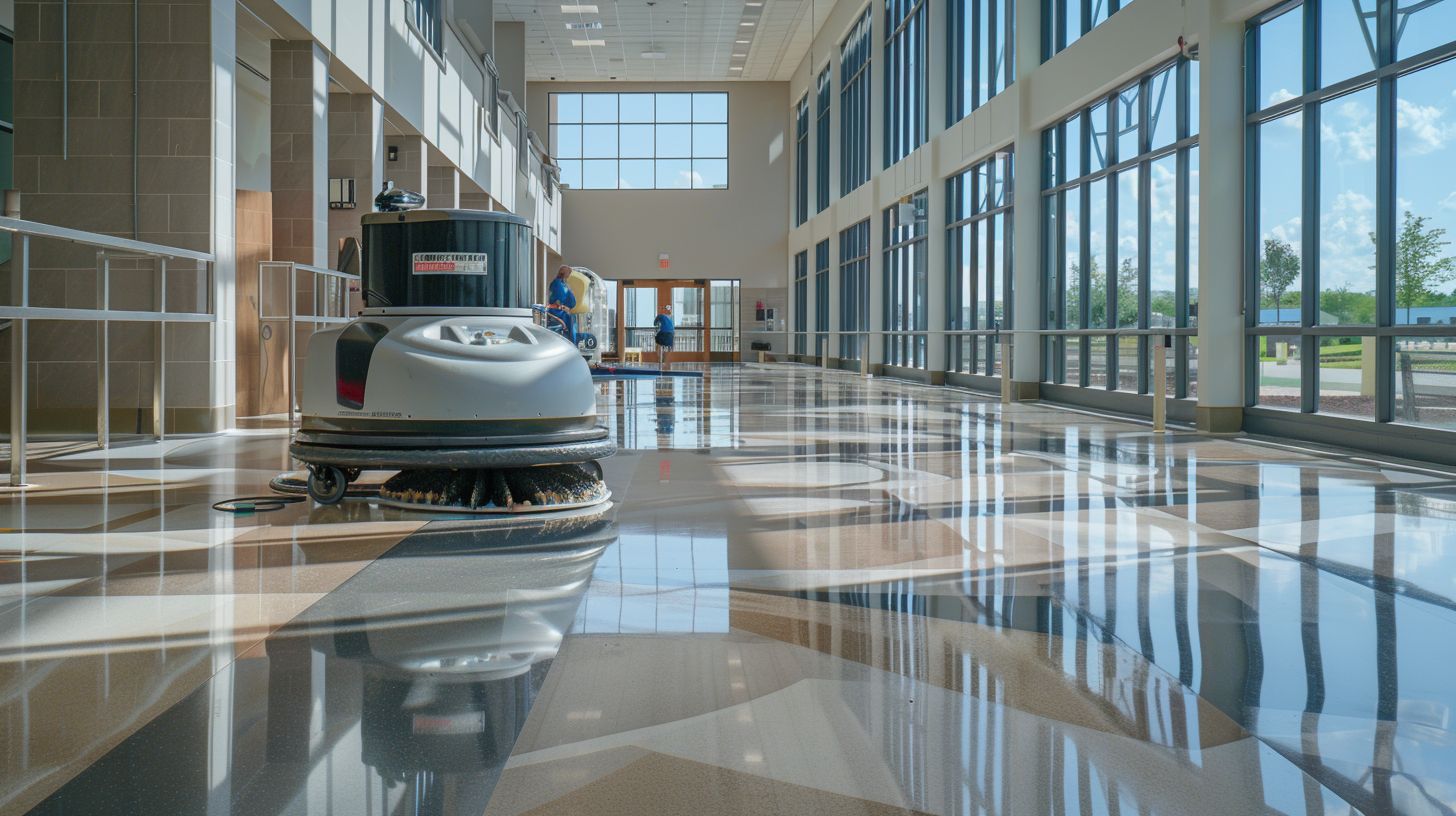
Clean different types of commercial flooring using appropriate tools, daily maintenance, and periodic restorative practices. For more details, continue reading!
Choosing the proper cleaning tools
Different commercial flooring types require specific cleaning tools and equipment. Microfiber mops are effective for daily maintenance of many floor surfaces, while a high-quality vacuum cleaner is essential for removing dirt and debris from carpets and rugs.
Specialized equipment like auto scrubbers can efficiently clean large areas of hard floors, such as concrete or tile, saving time and effort. To maintain cleanliness effectively, using the right cleaning supplies and equipment tailored to each type of flooring is crucial.
When choosing your cleaning tools, consider eco-friendly products that ensure the safety of building occupants while protecting the environment. Acidic cleaners should be avoided for marble or stone floors due to potential damage, whereas vinyl composition tile requires gentle yet thorough cleaning solutions to preserve its surface.
Daily maintenance
Daily maintenance is crucial to maintaining the appearance and durability of commercial floors. Here are the best practices for daily maintenance:
- Use high-grade commercial vacuum cleaners to remove loose dirt on carpeted floors effectively.
- Utilize a microfiber mop and neutral floor cleaner for daily cleaning of tile floors to prevent residue buildup.
- Sweep or vacuum hardwood, laminate, and vinyl floors to remove loose dirt and debris.
- Regularly clean concrete floors with a dust mop or vacuum to prevent dirt accumulation.
- Check rubber and stone floors for debris and spot clean as needed.
Periodic maintenance
Regular periodic maintenance is crucial for preserving various types of commercial flooring. Here are the best practices to keep in mind:
- Implementing a scheduled deep cleaning to remove deeply embedded dirt and grime.
- Sealants or top coatings should be applied to protect the floor’s surface from wear and tear.
- Buffing or burnishing to restore shine and luster to the flooring material.
- Inspecting for any signs of damage or wear that may require specialized attention, such as resealing or polishing.
To ensure your commercial floors remain in top condition, it’s essential to incorporate these periodic maintenance practices into your cleaning regimen.
Restorative maintenance of commercial floors
Restorative maintenance for commercial floors is essential to maintain long-term durability and appearance. It involves techniques tailored to each flooring type to remove common problems such as scuff marks, scratches, and embedded dirt. Here are the critical restorative maintenance practices:
- Stripping and Refinishing: This process rejuvenates heavily worn floors by removing old finish layers and applying new coats, enhancing their overall appearance and protection.
- Scrubbing and Sealing: Scrubbing the floor removes dirt and grime. Sealing it provides a protective layer against future damage and maintains its quality.
- Buffing and Polishing: Buffing smooths out minor imperfections on the floor surface, while polishing enhances its shine, contributing to an improved aesthetic.
- Stain Removal Treatments: Utilizing specialized techniques and products to eliminate stubborn stains from different commercial flooring surfaces effectively.
- Deep Cleaning Methods: Implementing deep cleaning methods such as steam cleaning or hot water extraction to remove deeply embedded dirt and grime from carpets and rugs.
- Repairing Damaged Areas: Addressing any damaged areas promptly by utilizing appropriate repair methods based on the specific flooring type to prevent further deterioration.
Restorative maintenance practices play a crucial role in preserving the condition of commercial floors, ensuring they remain attractive and functional for an extended period.
Eco-friendly practices
Using eco-friendly products and processes is crucial in commercial floor cleaning. Switching to environmentally friendly floor cleaners ensures building occupants’ safety and minimizes harmful environmental effects.
Sustainable practices and non-toxic solutions benefit people and the planet, reflecting a commitment to health, safety, and sustainability in commercial spaces.
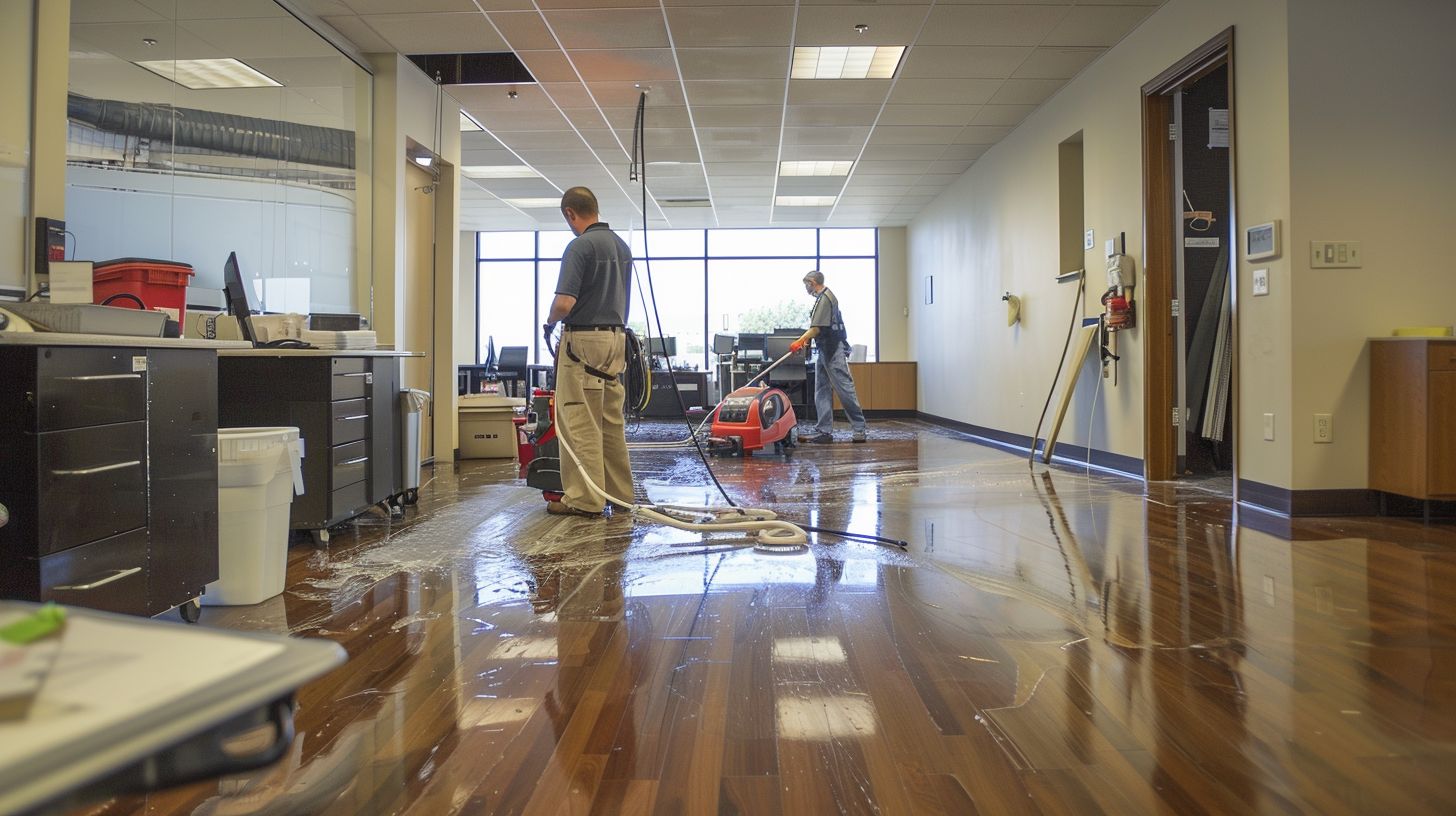
Common Problems and Solutions in Commercial Floor Cleaning
Removing scuff marks, scratches, and embedded dirt from wood floors requires targeted cleaning methods and specialized solutions. Learn more about effective problem-solving techniques in commercial floor cleaning.
Read on for valuable insights.
Scuff mark removal
To remove scuff marks from commercial floors, use a mild cleaner with a gentle scrubbing pad to avoid damaging the surface. Consider using a specialized cleaning solution for more stubborn scuffs on tile or stone floors.
Remember always to test the cleaning product in an inconspicuous area first. Invest in high-quality entrance mats to prevent dirt and debris from being tracked across the floor, minimizing scuff marks.
Try using a pencil eraser or a damp microfiber cloth when addressing scuff marks on vinyl or laminate flooring. Regularly clean rubber flooring with a neutral pH cleaner to preserve its appearance and reduce the visibility of scuffs and marks.
With concrete flooring, utilize specialized cleaners for effective removal of scuff marks without causing damage to the surface.
Scratch removal
Removing scratches from commercial or cleaning laminate floors requires careful attention and the right approach to avoid causing further damage. When dealing with scuffs on hardwood or laminate floors, consider using specialized cleaners and gentle scrubbing techniques to eliminate the blemishes without compromising the floor’s surface.
A mixture of warm water, mild detergent, and a soft brush can effectively diminish scratches on vinyl or tile floors. Addressing scratches promptly is crucial in preventing them from becoming more noticeable over time and thus maintaining the overall appearance of your commercial flooring.
Embedded dirt removal
To remove embedded dirt from commercial floors, you must use the right tools and techniques. Deep cleaning with a high-quality vacuum cleaner is crucial for carpeted commercial tile floors only to extract embedded dirt and maintain cleanliness.
Additionally, daily vacuuming helps prevent dirt buildup. Regular wet mopping with suitable cleaners removes embedded dirt and maintains its integrity on tile surfaces or concrete floors.
Proper maintenance routines are vital in keeping commercial floors free from embedded dirt.
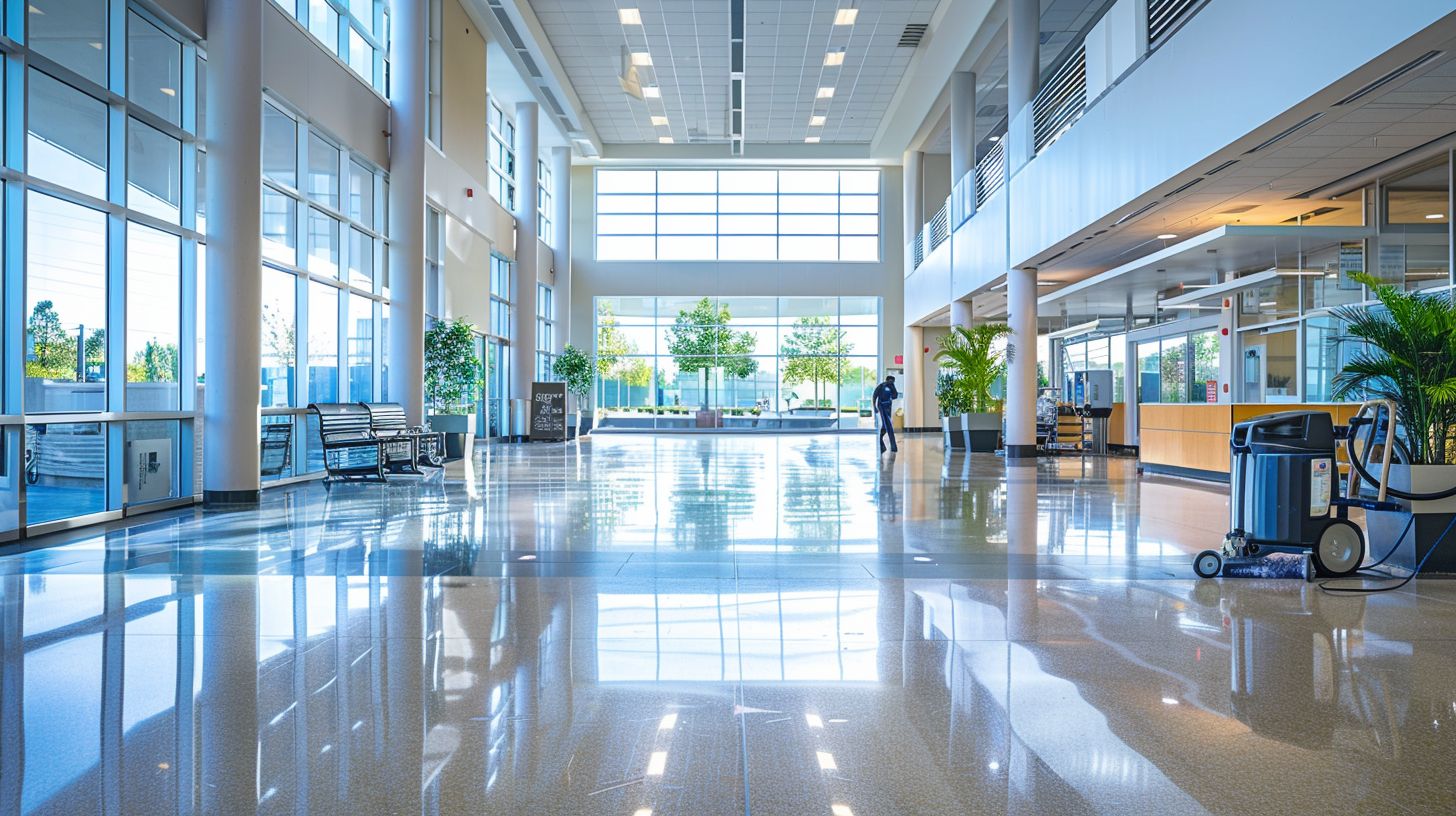
How to Create a Commercial Floor Maintenance Program
Understanding different floor types is crucial for creating a successful commercial floor maintenance program. By choosing the right cleaning supplies and equipment, establishing a cleaning schedule tailored to the specific needs of each floor type, and considering factors relevant to different industries, you can ensure a well-maintained and clean environment.
Understanding different floor types
Commercial flooring comes in various types, including carpet, tile, concrete, vinyl, laminate, rubber, and stone. Each type has unique cleaning requirements to maintain its appearance and longevity.
For instance, daily vacuuming with high-quality commercial vacuum cleaners is essential for keeping commercial carpets clean. Understanding the specific needs of each floor type is crucial in ensuring that suitable carpet cleaning methods and materials are used to preserve their quality.
Choosing the right cleaning supplies and equipment
Selecting the right cleaning supplies and equipment is essential when cleaning commercial floors. Here are the key considerations:
- Eco-friendly products and processes protect the environment and building occupants’ safety.
- Carpeted floors require high-quality vacuum cleaners and professional deep-cleaning equipment for steam cleaning and hot water extraction.
- Tile floors need microfiber mops, a neutral floor cleaner for daily cleaning, and automated scrubbers for periodic maintenance.
- Concrete floors demand pH-neutral cleaners, auto scrubbers, and appropriate dust-mopping tools for routine cleaning.
- Vinyl flooring requires suitable sweeping or vacuuming tools and mopping equipment using the right cleaning solution.
Establishing a cleaning schedule
To ensure the best care for different types of commercial flooring, it’s essential to establish a cleaning schedule that accommodates the specific needs of each type. Here’s how to do it:
- Assess each area’s foot traffic and usage patterns with different flooring types.
- Determine the frequency of daily maintenance tasks such as sweeping, vacuuming, or spot cleaning for high-traffic areas.
- Schedule periodic maintenance activities like mopping, deep cleaning, or buffing based on the type and condition of the flooring.
- Restorative maintenance practices such as stripping and refinishing for heavily worn floors should be considered by usage.
By staying consistent with a customized cleaning schedule, commercial floors can maintain their appearance and longevity effectively.
Factors to consider for different industries
Different industries have specific regulations and requirements for maintaining commercial floors. The type of foot traffic and usage in each sector will determine the frequency and intensity of maintenance needed.
For example, sectors like healthcare, food service, and manufacturing demand adherence to industry-specific sanitation standards. When creating a commercial floor maintenance program, it’s crucial to consider the potential impact of different cleaning materials on each industry’s specific activities and operations.
Dealing with common issues
Dealing with everyday issues in the process of commercial floor cleaning involves:
- Scuff mark removal: Use a mild detergent and a soft brush to scrub the scuff marks gently.
- Scratch removal: Use a floor cleaner and a microfiber cloth to buff out minor scratches. For deeper scratches, consider applying a specialized floor polish.
- Embedded dirt removal: Regular vacuuming or sweeping helps prevent dirt from becoming embedded. Use a high-quality vacuum cleaner for effective deep cleaning.
- Stain removal: Treat stains promptly using appropriate cleaning products and techniques tailored to the specific flooring material.
- Maintaining grout cleanliness: Clean grout lines thoroughly using vinegar and water or a commercial grout cleaner.
Remember to address these common issues promptly to maintain the cleanliness and appearance of your commercial floors.
Conclusion
In conclusion, maintaining different types of commercial flooring requires specific cleaning methods and practices. Daily vacuuming for carpets, regular mopping for tile floors, and using specialized cleaners for the hardwood floors, laminate, and vinyl are essential.
Regular maintenance, such as routine cleaning and complete drying, is crucial for concrete floors to prevent dirt absorption. Implementing a floor cleaning schedule tailored to different floor types and addressing common problems like scuff marks and scratches is vital.
Professional commercial floor cleaning equipment and services can offer expertise that contributes to a professional environment while saving time and costs.
FAQs
1. What are the best practices for cleaning commercial tile floors?
Use high-quality vacuum cleaners and professional cleaning services to remove dirt before mopping with a suitable cleaner.
2. How do you deep clean commercial carpets?
Hire a professional cleaning team that uses powerful equipment to extract stubborn dirt, stains, and allergens from carpets.
3. Can you use the same methods to clean laminate and hardwood floors in commercial spaces?
No, clean laminate floors with gentle cleaners and avoid water pooling; for clean hardwood floors, use specific wood cleaners and keep them dry.
4. What equipment is essential for commercial floor cleaning?
Effective cleaning requires high-quality vacuum cleaners, mops designed for different floor types, and specialized cleaning solutions.
5. How should I maintain vinyl and concrete floors in my business area?
Clean vinyl floors with mild soap solutions regularly; use sealers on concrete floors after thorough sweeping or vacuuming to prevent stains.
Contact Whitehall Carpet Cleaning today for all your floor, rug, and upholstery cleaning, disaster restoration, tile and grout cleaning, and disinfection services!
